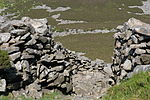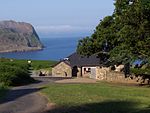Trefor Quarry railway
1 ft 11½ in gauge railways in WalesIndustrial railways in WalesRailway lines closed in 1962Railway lines opened in 1850United Kingdom rail transport stubs ... and 1 more
Use British English from September 2017
The Trefor Quarry railway was an industrial, 1 ft 11+1⁄2 in (597 mm) narrow-gauge railway connecting the Trefor granite quarry with the pier at Llanaelhaearn on the Llŷn Peninsula.
Excerpt from the Wikipedia article Trefor Quarry railway (License: CC BY-SA 3.0, Authors).Trefor Quarry railway
A499,
Geographical coordinates (GPS) Address Nearby Places Show on map
Geographical coordinates (GPS)
| Latitude | Longitude |
|---|---|
| N 52.984 ° | E -4.412 ° |
Address
A499
LL54 5AD , Llanaelhaearn
Wales, United Kingdom
Open on Google Maps









